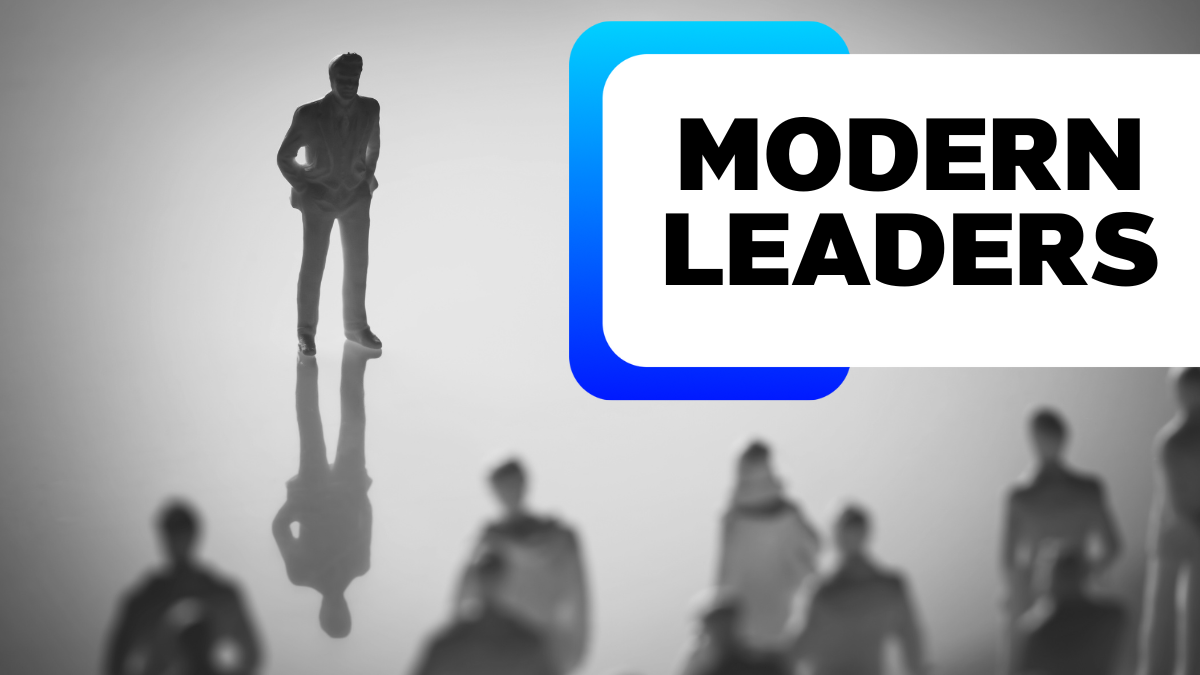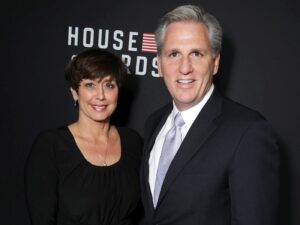Dive into the realm of modern leaders, where dynamic theories and styles converge with influential figures shaping our world. From transformational visionaries to political trailblazers, this article unravels the essence of effective leadership in today’s ever-changing landscape.
In an era of smartphones and self-driving cars, leadership isn’t just about bossing people around – it’s an art form! Enter the realm of modern leaders, the wizards of the corporate castle, the architects of change in this fast-paced world.
In a world that often feels like a jungle, modern leaders are our trusty guides, hacking through the thicket of challenges. They’re like the GPS in the business world, showing the way through uncharted territory.
In this fast-paced era, having a strong leader is like having a seasoned captain in a storm. They’re the glue that keeps everything from falling apart, the beacon in our darkest moments. Without effective leadership, it’s like running a marathon barefoot – you might make some progress, but it will be a painful journey.
This article takes you on a wild ride through their world, dissecting the diverse theories and styles that fuel their success while introducing you to the powerhouses that are flipping the script in industries and societies alike.
The role of modern leaders
Picture a symphony without a conductor, musicians playing their tunes, chaos reigning supreme. That’s what a world without effective leaders would look like. In contrast, a modern leader conducts the orchestra, ensuring every instrument plays its part to create a beautiful melody of success.
In this age of rapid change, a leader is like a skilled surfer, riding the waves of innovation with finesse. They’re not just keeping up; they’re setting the pace, showing others how to catch the next big wave. Without them, organizations risk being left in the shallow end while the competition rides the big ones.
Importance of modern leadership

Effective leadership today is like a smoothly running machine. It’s not just about the parts; it’s about how they work together seamlessly. A modern leader ensures every cog turns smoothly, maximizing productivity and propelling the organization forward.
So, in this whirlwind of modernity, leaders aren’t just figureheads; they’re the engine that drives progress. They’re the glue, the rudder, the conductor, the surfer, and the engineer – all rolled into one. Without them, we’d be adrift in a sea of chaos, desperately seeking direction. With them, we’re on course for a future of limitless possibilities.
Theories on modern leaders
In the dynamic realm of modern leadership, success isn’t a matter of chance but a carefully crafted strategy. This section unravels the bedrock of effective leadership, exploring the prominent theories that guide today’s trailblazers.
- Transformational leadership
- Servant leadership
- Authentic leadership
- Transactional leadership
Transformational leadership
In the world of leadership, Transformational Leadership isn’t just a fancy term – it’s like a conductor leading a symphony of progress. This section strips away the jargon and gets down to the nitty-gritty, exploring what it means, how leaders use it, and why it’s a game-changer for organizations.
Definition and core principles
Think of a transformational leader as a coach with a killer playbook. They’ve got four key strategies up their sleeve:
- Dream weaver:They’ve got a vision that’s more vivid than a Technicolor dream. This vision gives their team a sense of purpose and direction.
- Cheerleader extraordinaire:They’re the ultimate hype squad. They pump up their team, build their confidence, and revive everyone to tackle challenges.
- Personal touch:They’re like a tailor, crafting a unique suit for each team member. They know everyone’s strengths and weaknesses and use that knowledge to help them grow.
- Thought provoker:They’re not afraid to shake things up. They encourage creativity, ask the tough questions, and create an environment where innovation thrives.
Examples of leaders
Think of Nelson Mandela as the ultimate transformational leader – he saw a rainbow when others saw a storm cloud. His vision for a united South Africa inspired a nation. And then there’s Steve Jobs, the tech world’s rockstar. His vision for Apple revolutionized the way we interact with technology.
Impact on organizational success
Imagine a workplace where everyone’s fired up, motivated, and loving what they do. That’s the magic of transformational leadership. It boosts morale, ramps up productivity, and takes performance to a new level. It’s like pouring rocket fuel on a campfire – the flames of innovation and growth leap higher and higher.
In a nutshell, transformational leadership isn’t just a leadership style; it’s a superpower. It’s the secret sauce that turns ordinary teams into dream teams and organizations into industry leaders. With its visionary approach and unwavering support, it’s the driving force behind monumental success stories.
Servant leadership
Servant Leadership isn’t about wearing a crown; it’s about handing out umbrellas in the rain. This section breaks it down – what it means, who’s doing it right, and why it’s the secret weapon for organizational success.
Definition and core principles
Think of a servant leader as the ultimate team player, the one who passes the ball for others to score. Here are the four key principles they live by:
- Empathy in action:They don’t just talk the talk, they walk the walk. They understand their team’s struggles and actively seek ways to support and uplift them.
- Listening with intent:They’ve got ears like radar dishes, tuned in to the needs and ideas of their team. They value every voice and make sure everyone is heard.
- Hearts of service:It’s not about being a doormat; it’s about being a helping hand. They roll up their sleeves and jump into the trenches alongside their team, leading by example.
- Building community:They’re like architects of unity, fostering an environment of trust, collaboration, and a shared sense of purpose among their team members.
Examples of leaders
One shining example of a servant leader is Mahatma Gandhi. He didn’t lead with power; he led with compassion and a deep commitment to the welfare of his people. Then there’s Mother Teresa, whose selfless dedication to the poor and marginalized set a global standard for servant leadership.
Impact on organizational success
Imagine a workplace where everyone feels seen, heard, and valued. That’s the magic of servant leadership. It creates a culture of trust and mutual respect, where team members feel empowered to bring their best to the table.
This translates into higher levels of employee engagement, productivity, and ultimately, organizational success. It’s like having a team of inspired superheroes, ready to conquer any challenge that comes their way.
In a nutshell, servant leadership isn’t about being a kingpin; it’s about being a champion for your team. It’s the secret sauce that turns groups into tight-knit communities, and organizations into powerhouses. With its empathetic approach and unwavering support, it’s the driving force behind remarkable success stories.
Authentic leadership
Authentic leadership isn’t about putting on a show; it’s about being real in a world full of facades. This section gets to the heart of it – what it really means, who’s embodying it, and why it’s a game-changer for organizational triumph.
Definition and core principles
Think of an authentic leader as a lighthouse in a storm, unwavering and true. They live by four fundamental principles:
- Transparency matters:They’re like open books, sharing their thoughts, feelings, and motives with honesty and integrity.
- Staying true to themselves: They don’t wear masks; what you see is what you get. They’re consistent in their values and actions.
- Relational rapport:They’re not just leaders; they’re mentors, coaches, and friends. They build deep, meaningful connections with their team members.
- Unwavering integrity: They’re like beacons of integrity, upholding high ethical standards and doing what’s right even when it’s tough.
Examples of leaders
One shining example of an authentic leader is Oprah Winfrey. Her journey from adversity to success has been an open book, and she uses her platform to inspire and uplift others. Then there’s Warren Buffett, whose down-to-earth approach and unwavering principles have made him a beacon of authenticity in the business world.
Impact on organizational success
Imagine a workplace where trust flows like a river, where team members know they can rely on their leader to do right by them. That’s the power of authentic leadership. It fosters an environment of trust, transparency, and psychological safety, where innovation and collaboration thrive.
This, in turn, leads to higher levels of employee engagement, retention, and organizational success. It’s like having a team of dedicated partners, all rowing in sync towards a common goal.
In a nutshell, authentic leadership isn’t about putting on a facade; it’s about being a beacon of authenticity in a world of pretense. It’s the secret sauce that turns teams into families, and organizations into beacons of excellence. With its genuine approach and unwavering principles, it’s the driving force behind extraordinary success stories.
Transactional leadership
Transactional leadership is like a well-run business – it’s all about setting clear expectations and making sure everyone gets what they agree on. In this section, we’ll break down what it means, who’s acing it, and why it’s a key player in organizational success.
Definition and core principles
Imagine a transactional leader as a manager running a tight ship. They live by four core principles:
- Clear expectations:They’re like the signposts on a road, letting everyone know where they stand and what’s expected of them.
- Rewards and consequences:Just like a well-structured bonus system, they make sure that performance is met with appropriate rewards, while shortcomings face consequences.
- Structured systems:They’re all about routines and processes, creating a stable and predictable work environment.
- Active management:They’re not distant figures; they’re hands-on managers, keeping a close eye on progress and intervening when necessary.
Examples of leaders
A classic example of a transactional leader is Jack Welch, former CEO of General Electric. He was known for setting clear performance targets and rewarding those who met them. Another example is Vince Lombardi, the legendary Green Bay Packers coach, who was known for his strict adherence to performance standards and accountability.
Impact on organizational success
Imagine a workplace that runs like a well-oiled machine, with everyone knowing their role and what’s expected of them. That’s the magic of transactional leadership. It provides structure and clarity, ensuring that tasks are completed efficiently and goals are met. This leads to a culture of accountability and results-driven performance, contributing significantly to organizational success. It’s like having a team of well-trained racehorses, all galloping towards the finish line with precision.
In summary, transactional leadership isn’t about micromanaging; it’s about setting clear rules of engagement. It’s the secret sauce that turns potential into performance, and organizations into high-performing entities. With its structured approach and results-driven mindset, it’s a key player in achieving remarkable success stories.
These theories serve as the compass for modern leaders, guiding them through the complexities of the contemporary landscape. Each approach brings its unique strengths to the table, showcasing the diverse toolkit available to today’s leaders in their pursuit of success.
Which leadership style is best?
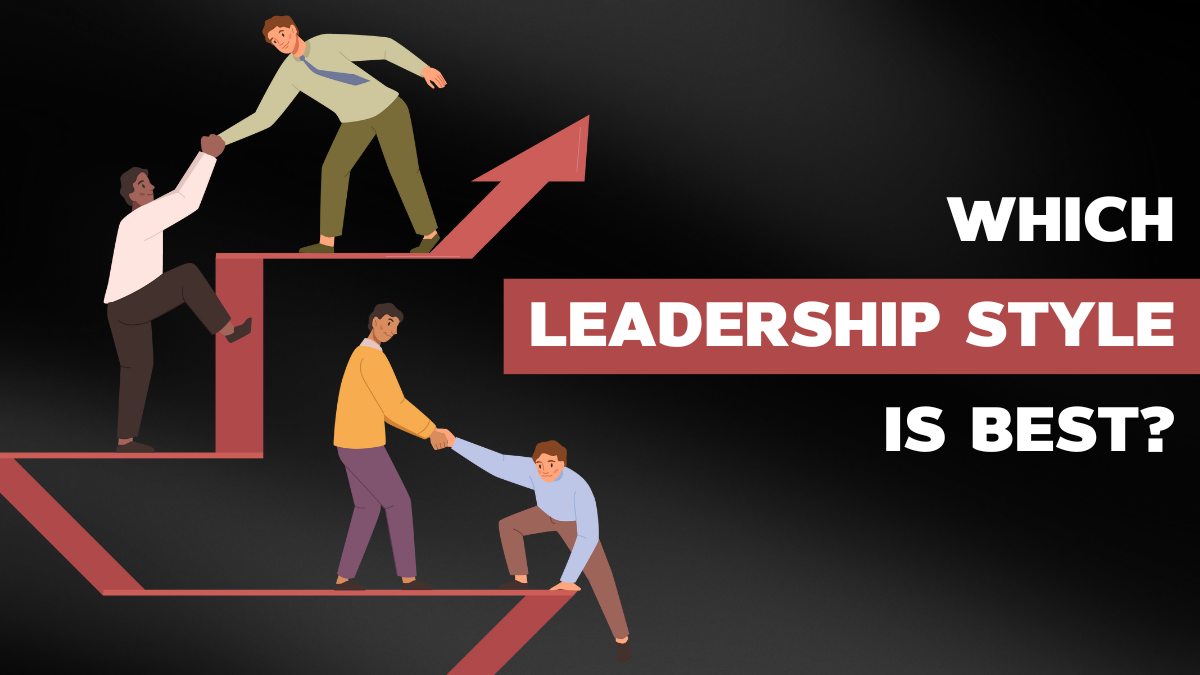
In the ever-evolving landscape of leadership, finding the optimal style is akin to selecting the right tool for the job. This section navigates the complexities, shedding light on contextual considerations, the art of balance, and emerging trends that guide modern leaders toward success.
- Contextual considerations
- Balancing different styles
- Emerging trends in modern leaders
Contextual considerations
Recognizing the importance of situational leadership
Imagine a leader as a skilled driver, navigating through different terrains. Recognizing situational leadership is like knowing when to shift gears – it’s about adapting your approach to match the specific challenges and opportunities at hand.
Matching leadership style to organizational needs
Think of an organization as a puzzle, with each piece needing the right fit. Effective leaders are like puzzle masters, understanding that different situations call for different approaches. They tailor their leadership style to suit the unique needs and goals of their organization.
Balancing different styles
The art of integrating various leadership styles
Consider a chef crafting a gourmet meal. Just as they blend diverse ingredients to create a masterpiece, effective leaders blend various leadership styles to achieve optimal results. It’s about knowing when to be visionary when to be hands-on, and when to empower others.
Strategies for adapting leadership
Imagine a captain steering a ship through changing weather. A leader in a dynamic environment must be as adaptable as the wind. They employ strategies like open communication, flexibility, and a keen awareness of shifting dynamics to navigate their team through uncertainty.
Emerging trends in modern leaders
Exploring new paradigms in leadership theory
Think of leadership theory as a toolbox, constantly evolving with new, innovative tools. Modern leaders are like craftsmen, exploring these fresh approaches to find the best fit for their teams and organizations.
The role of technology and innovation
Picture technology as a powerful ally, propelling organizations into the future. Modern leaders harness this power, adapting their styles to leverage technological advancements, fostering innovation, and staying at the forefront of progress.
In essence, the quest for the best leadership style is a dynamic journey, one that requires a keen understanding of context, a mastery of adaptability, and a forward-thinking approach to emerging trends. By navigating these considerations, modern leaders pave the way for their organizations to thrive in an ever-changing world.
Current modern leaders
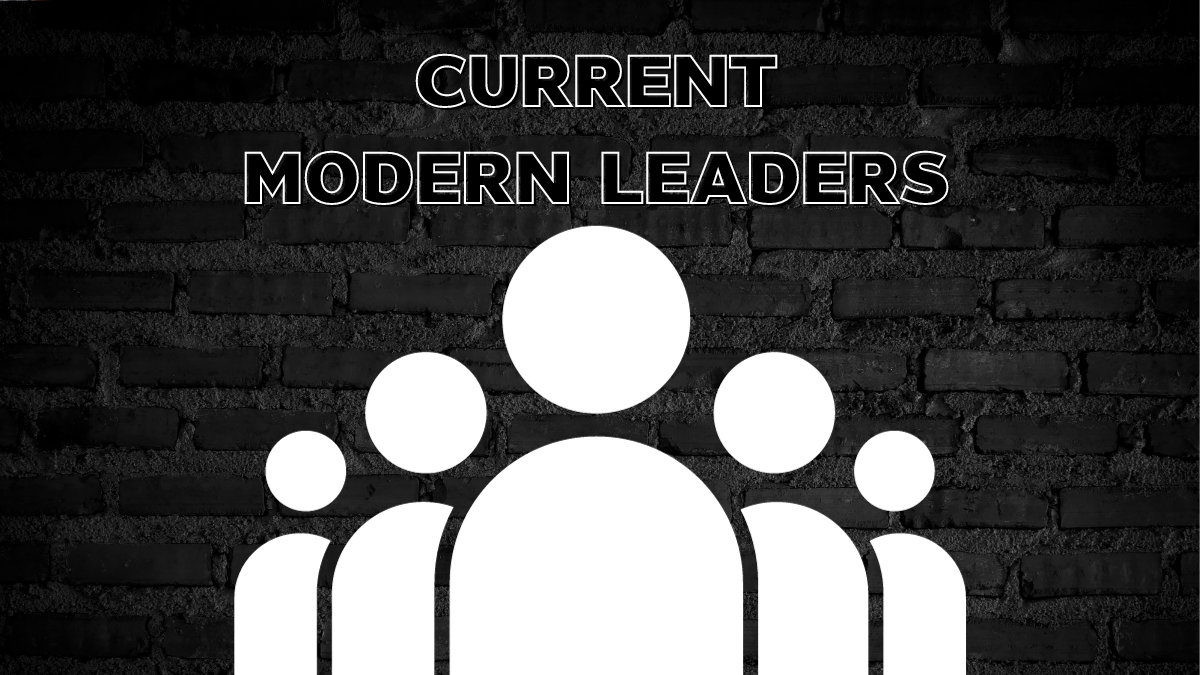
The following categories of people can be called our modern leaders. Let’s take a look at who they are.
- Political leaders
- Business leaders
- Social and cultural leaders
Political leaders
In the high-stakes world of global politics, leaders act as the captains of their respective ships, navigating through storms and charting new courses. Let’s take a closer look at some of the prominent figures currently at the helm, guiding their nations with vision and determination.
| Name | Position | Description |
| Joe Biden | President of the United States | Joe Biden inaugurated on January 20, 2021, steps onto the political stage like a seasoned actor taking center stage. His career, a tapestry of dedication and experience, weaves back to his days as Vice President under Barack Obama. With a focus on unity and addressing pressing issues, Biden approaches leadership like a conductor orchestrating harmony in a symphony. |
| Angela Merkel | Former Chancellor of Germany (retired in 2021) | Angela Merkel, the matriarch of European politics, held Germany’s reins for a remarkable 16 years, akin to a steadfast lighthouse guiding ships through rough seas. Her pragmatic approach helped stabilize the European Union during times of uncertainty. |
| Boris Johnson | Prime Minister of the United Kingdom | Boris Johnson, the charismatic maestro of British politics, assumed office on July 24, 2019. His leadership style is like a rollercoaster ride, filled with unexpected turns and exhilarating moments. Johnson’s determination shines through as he navigates the intricate maze of Brexit and steers the UK through the tempestuous waters of a global pandemic. |
| Emmanuel Macron | President of France | Emmanuel Macron, the modern-day phoenix of French politics, took the reins on May 14, 2017, bringing fresh energy and a digital-age perspective. His approach to leadership is like a savvy entrepreneur, aiming to modernize France’s economic landscape and strengthen ties within the European community. |
| Justin Trudeau | Prime Minister of Canada | Justin Trudeau, Canada’s political rockstar, has been Prime Minister since November 4, 2015. With a blend of charisma and genuine empathy, Trudeau’s leadership feels like a warm hug, focused on climate action, social equality, and economic growth. |
| Narendra Modi | Prime Minister of India | Narendra Modi, the architect of India’s future, assumed office on May 26, 2014. His dynamic leadership style is akin to a masterful DJ, blending economic reforms, digital innovation, and diplomatic finesse to create a harmonious political landscape. |
| Scott Morrison | Prime Minister of Australia | Scott Morrison, Australia’s unflappable skipper, took the helm on August 24, 2018. His leadership style is like a skilled surfer, riding the waves of challenges from bushfires to a global pandemic, always with an eye on the horizon. |
These leaders, each with their unique approach and style, stand at the helm of their nations, steering through turbulent waters with a blend of experience, vision, and adaptability. Their decisions ripple through history, shaping the destinies of their countries and leaving an indelible mark on the world stage.
Business leaders
In the dynamic world of business, certain individuals emerge as true trailblazers, wielding influence and reshaping entire industries. Let’s dive into the stories of these exceptional modern business leaders, whose innovative thinking and strategic brilliance have propelled their companies to unprecedented heights.
| Name | Position | Description |
| Elon Musk | CEO and Founder of SpaceX, CEO and Product Architect of Tesla, Inc. | Picture Elon Musk as a real-life Tony Stark, engineering rockets and electric cars. He’s the genius behind Tesla, making electric vehicles cool, and SpaceX, aiming for Mars. Musk’s drive for sustainability and cosmic exploration sets him apart as a visionary leader in a league of his own. |
| Tim Cook | CEO of Apple Inc. | Tim Cook inherited the Apple throne from the legendary Steve Jobs, and he’s been conducting Apple’s orchestra ever since. Under his baton, Apple continues to hit the high notes of innovation, producing iconic products that define our digital era. Cook’s strategic brilliance has turned Apple into a symphony of tech excellence. |
| Sheryl Sandberg | COO of Meta Platforms, Inc. (formerly Facebook) | Sheryl Sandberg is the compass for women in tech, steering them towards success. Her role at Facebook (now Meta) has been like a guiding star in the digital universe. Beyond boardrooms, Sandberg champions equality, breaking barriers for women in leadership roles. |
| Satya Nadella | CEO of Microsoft | Satya Nadella grabbed the reins at Microsoft and took it to cloud nine. His leadership style is like a jazz maestro, orchestrating innovation and transforming Microsoft into a cloud computing powerhouse. Nadella’s visionary approach has brought Microsoft back into the limelight. |
| Mary Barra | Chairman and CEO of General Motors | Mary Barra is like a driving force in the male-dominated automotive world, steering General Motors towards a sustainable future. Her tenure has been a race towards innovation in electric and autonomous vehicles, revolutionizing the way we think about driving. |
| Warren Buffett | Chairman and CEO of Berkshire Hathaway | Warren Buffett is the wizard of Wall Street, turning investments into gold. His savvy, patient approach to investing has made him a legendary figure. At the helm of Berkshire Hathaway, he’s woven a tapestry of financial success. |
| Larry Page and Sergey Brin | Co-Founders of Google (now Alphabet Inc.) | Larry Page and Sergey Brin are the dynamic duo who turned a garage project into a digital empire. Their collective genius gave us Google, shaping the way we access information. Their journey is a testament to the power of audacious dreams and brilliant execution. |
These modern business leaders are not just captains of industry; they are visionaries, conductors, and cosmic explorers, each charting their unique course through uncharted territory.
Their influence reaches far beyond boardrooms, inspiring a new wave of entrepreneurs and leaders. As they continue to innovate and push boundaries, their legacy will resonate in the annals of business history for generations to come.
Social and cultural leaders
In a world filled with complexities, there are those who don’t just speak up, but stand up, making waves that ripple far and wide. These leaders are the engines driving change, shaping our world in ways both profound and practical. Here, we shine a light on some of the brightest stars in the constellation of modern social and cultural leaders.
| Name | Position | Description |
| Malala Yousafzai | Education and Women’s Rights Activist | Picture Malala Yousafzai as a torchbearer for education, fearlessly advocating for girls’ right to learn. Surviving a brush with danger, Malala emerged as a global symbol for educational empowerment. Her journey reads like a superhero origin story, inspiring millions along the way. |
| Greta Thunberg | Environmental Activist | Greta Thunberg, the Swedish dynamo, stormed onto the scene like a climate avenger. Her school strikes for climate action were like flares in the night sky, rallying young minds worldwide to demand a greener, healthier planet. Greta’s passion is a force of nature, reshaping how we view environmental activism. |
| Ta-Nehisi Coates | Author and Social Commentator | Ta-Nehisi Coates, the American wordsmith, wields his pen like a knight’s sword, cutting through the underbrush of race, identity, and social justice. His works are a tapestry of conversations, woven with threads of truth, pushing us all to confront uncomfortable realities. |
| Ava DuVernay | Filmmaker and Activist | Ava DuVernay, the cinematic maestro, directs narratives that hit like a punch to the gut, driving home messages of racial inequality and systemic injustice. Her films aren’t just stories; they’re wake-up calls, ringing loud and clear in the echo chambers of societal change. |
| Bryan Stevenson | Civil Rights Attorney and Activist | Bryan Stevenson, the legal luminary, strides through courtrooms like a crusader for justice, fighting for racial equity and criminal reform. His victories aren’t just legal; they’re moral, chipping away at the bedrock of systemic injustice. |
| Ai Weiwei | Contemporary Artist and Activist | Ai Weiwei, the artistic alchemist, turns brushes and chisels into weapons of social change. His art isn’t confined to galleries; it’s a guerrilla assault on oppressive regimes and a rallying cry for human rights. |
| Chimamanda Ngozi Adichie | Author and Feminist Advocate | Chimamanda Ngozi Adichie, the Nigerian literary powerhouse, crafts stories that are more than narratives; they’re blueprints for change. Her voice isn’t just heard; it’s amplified, echoing in the hearts of women and girls globally. |
These modern torchbearers aren’t just leaders; they’re titans, reshaping the world with every step. Their stories are not just biographies; they’re anthems, inspiring us all to take up the mantle of change. As they continue to stride forward, their influence will be felt for generations to come.
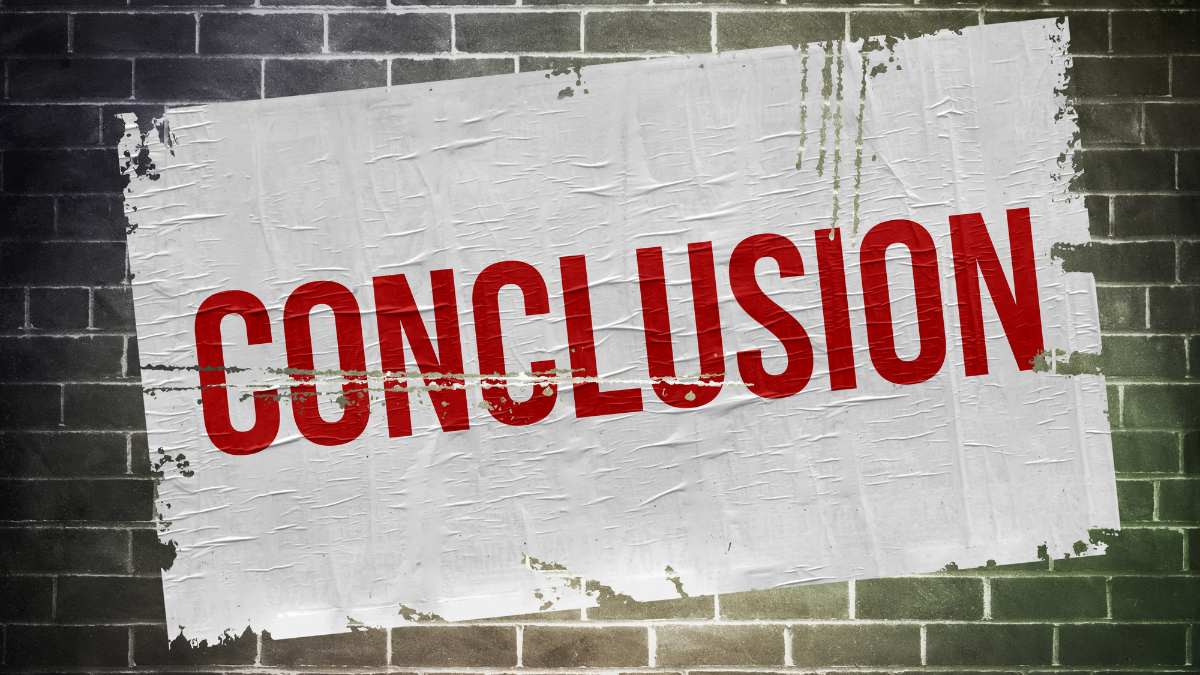
Conclusion
In this exploration of modern leadership, figures like Malala and Greta have shown us that leadership transcends traditional boundaries. Their impact underscores the need for adaptable, empathetic leaders in an ever-changing world. The future of leadership isn’t a distant concept; it’s a journey we embark on today, guided by those who lead with purpose and vision.

